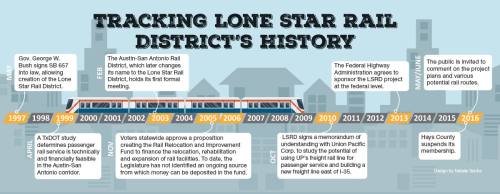Elected officials who sit on the policy board for the Capital Area Metropolitan Planning Organization are scrutinizing development of a proposed commuter rail line between San Antonio and Georgetown now that a vital player has dropped out of the project.
Lone Star Rail District had been seeking to put the proposed $2.4 billion commuter rail line on the existing Union Pacific Corp. freight rail line. Regional UP freight would have been transferred to a new line to be built east of I-35.
In February, UP terminated an agreement with the LSRD that would have been a stepping stone to eventually allowing a commuter rail project to use the freight company’s existing lines.
“Over the course of the past six-plus years of meetings, discussions and studies, it has become apparent that the desired track alignments and infrastructure requirements necessary to support the efficient and reliable comingling of freight and commuter passenger rail are unattainable,” wrote Jerry Wilmoth, UP’s general manager of network infrastructure.
CAMPO’s decisions
On March 21, CAMPO board members peppered LSRD and Texas Department of Transportation officials with questions about how to move forward on the project. The CAMPO board approved reassessing the project and looking at other viable alternatives to bring back for discussion at its June 6 meeting.
Board members also expressed concern about how LSRD has spent $26 million in state and federal funds.
“I’m concerned that we’re looking at a boondoggle,” said Cynthia Long, a CAMPO board member and Williamson County commissioner. “We have spent a lot of public money on a lot of public studies and have nothing to show for it.”
LSRD Director Joe Black said most of the money allocated from CAMPO has been spent on consultants because LSRD only has two full-time employees.
Several board members, including Council Member Craig Morgan, who represents Round Rock, wanted to freeze spending until the June 6 meeting.
“Now that UP has withdrawn, I have some major concerns that Lone Star Rail has spent $26 million on consultants, and we have nothing to show for it,” Morgan said.
However, Black said to reassess the project as indicated by the board’s March 21 vote would require using the consultants. The motion to freeze spending failed with 9-10 vote.
Moving forward
Black insists UP’s termination of the agreement has not fundamentally changed the project despite generating some bad press. The district, which is currently in the middle of an environmental study that could be complete in mid-2018, is continuing work on the project as if nothing happened, he said.
“Public perception-wise [UP’s announcement] was a big hit because people immediately assumed we were dead, and the project is never going to happen,” Black said. “We’re confident we’re going to be able to find a solution.”
Other officials have not been as optimistic. Morgan said he believes the proposed route as it exists is “on its last breath.”
Morgan said he is open to rail and any other forms of regional transportation, “but we have to do it in a way that makes sense to the taxpayer.”
Round Rock Mayor Alan McGraw said he was skeptical of LSRD’s viability, but there is still a need for greater regional connectivity.
“There are multiple organizations that could provide the lead for [greater regional connectivity],” he said. “But it’s going to take some other funding mechanism and some other regional transportation effort for it to work.”
McGraw said city officials are looking at a variety of regional transportation alternatives, including burgeoning technology, such as autonomous vehicles or pods similar to the urban light transit, or ULTRa, system in London’s Heathrow Airport. “We’re big proponents of looking at the transportation technology of tomorrow,” he said.
At a meeting April 15, LSRD presented four alternatives to the initial preferred route on the existing UP line. Those alternatives include one proposal to build the rail line parallel to the existing UP line, two proposals to build it along I-35, and a proposal to build it along SH 130.
If using UP’s line is deemed the most efficient path forward, the district will look to reopen negotiations with the freight carrier, he said.
UP Media Director Jeff DeGraff said UP will focus on projects aimed at expanding capacity on its current line now that it has terminated its agreement with LSRD. Freight traffic within the Austin-San Antonio corridor has increased 60 percent during the past 10 years, and combining freight and passenger rail traffic was of concern to the company, he said.
“[UP had] some specific concerns we informed Lone Star Rail about early in this process,” DeGraff said. “Ten years later, we’ve looked at their plans and proposals, and we haven’t seen any progress as far as addressing our concerns.”
Bill Bingham, an attorney representing the district, said he thought the concern regarding freight and passenger rail traffic had been sufficiently addressed through the discussions so far.
Bingham said the plan to address UP’s capacity concerns included relocating the rail east of I-35 so regional freight could pass through cities without affecting commuter traffic. Local freight, to be delivered from one city to another within the region, would remain on the line west of I-35.
“We have developed a plan that provides them additional capacity to operate their freight operation,” he said. “We really thought we had resolved that question, so we need to discuss that with them to understand how that concern arises.”
LSRD started the environmental study process in October 2014 and began analyzing seven route alignments, including the UP line, in early 2016. Black said UP has a history of changing its mind on projects so LSRD should keep UP options in the analysis, but he did say that the company could be out of the process forever, and if so the use of their lines is no longer be an option.
Additional reporting by Scott Thomas





